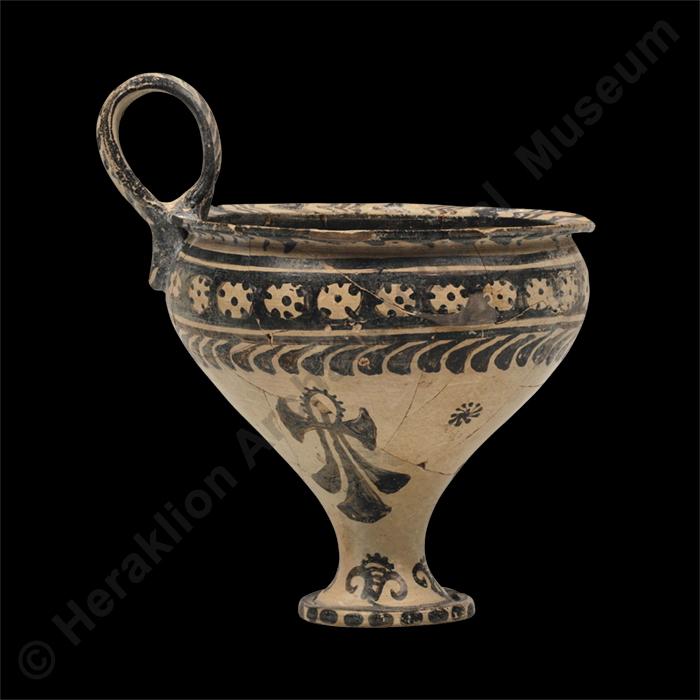Cup-rhyton in the Special Palatial Tradition
Π8407
Clay
Incomplete, mended and restored
Height: 14.5 cm. Rim diameter: 15.5 cm. Diameter of hole: 0.4 cm.
Phaistos
Palace - sottoscala 51
Late Bronze Age, Neopalatial period, Late Minoan IB period:
1500-1450 BC:
Gallery:
IVCase:
41Exhibition thematic unit:
Late Bronze Age - Neopalatial period (1700-1450 BC). The New Palaces. The zenith of Minoan civilisationPalaces. Palatial buildings. Palaces of Phaistos and Malia
Description
This cup functions as a rhyton because it has a hole in the bottom, making it a libation vessel rather than a drinking vessel. The grooves on the handle and around the base show that it is definitely modelled on similar vessels made of metal. The eclectic formal affinities between clay and metal artefacts are represented here by elements such as the shape of the raised strap handle with relief knob on the body, the tight outlines of the rim and tall-footed body, the fine walls and the shiny surface. The decoration follows the Special Palatial Tradition that dominates the vase-painting of the Late Minoan IB period, specifically the Alternating Style, with the repetition of the main decorative theme, the double axe with sacral knot. There are dotted rosettes and a foliate band on the shoulder, and a stylised papyrus motif on the foot. The double axe combined with the sacral knot indicates that the cup was used as a ritual libation vessel. The double axe, one of the most recognisable religious symbols of the Minoan civilisation, is linked to bull sacrifice. The motif conventionally termed a "sacral knot" is believed to represent a garment of symbolic significance which may have signalled the content of religious ceremonies and/or have been a distinguishing mark of the priestesses who took part in them.Bibliography:
Pernier L. and L. Banti. Il palazzo minoico di Festòs : scavi e studi della Missione archeologica italiana a Creta dal 1900 al 1950, Roma, 1951, 271-275, no 1, 492, fig. 171. Koehl, R.B. Aegean Bronze Age Rhyta. INSTAP Prehistory Monographs 19. Philadelphia, Penn., 2006, 237, no 1248, fig. 44. Betancourt, P.P. The History of Minoan Pottery. Princeton, 1985, pl. 22ΣΤ.Author:
I. N.Photographs' metadata
